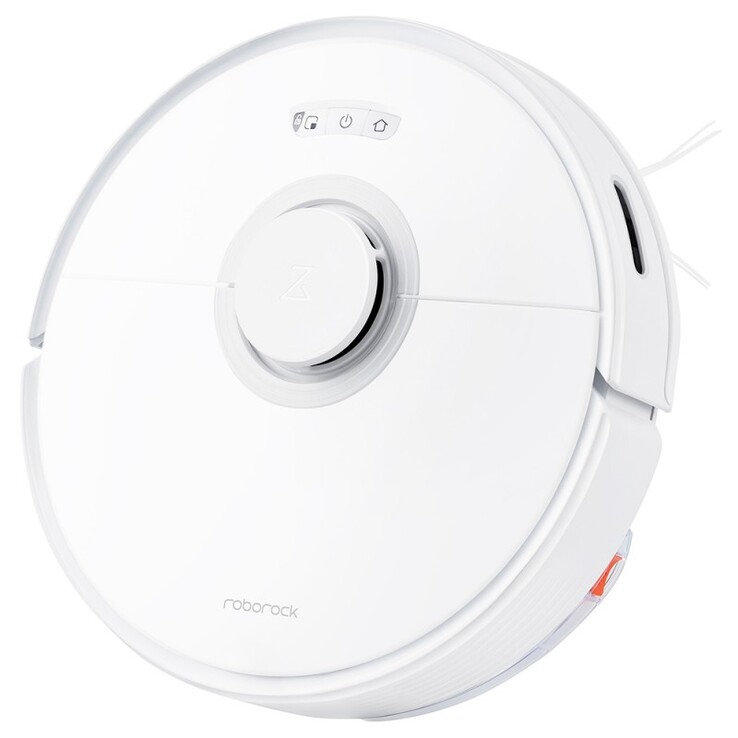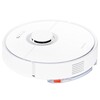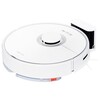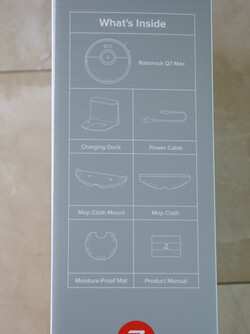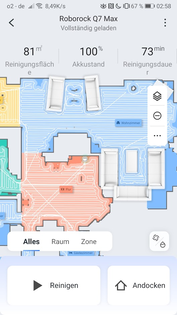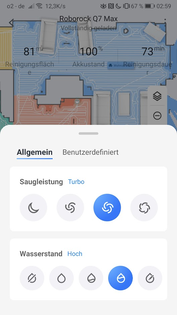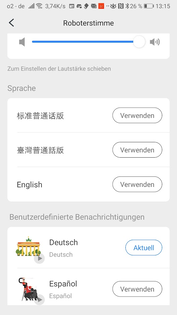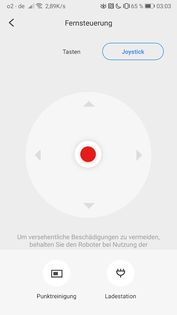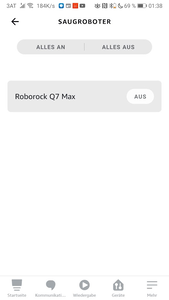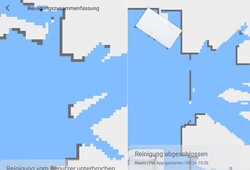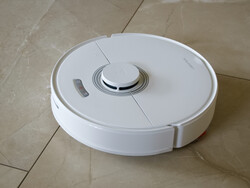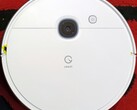Roborock Q7 Max robot vacuum cleaner in review: High suction power at a fair price
The Roborock Q7 Max is an efficient vacuum robot with mopping function. Thanks to strong suction performance, LiDAR navigation and many small features, the robot vacuum cleaner can convince in the test. The Roborock proves to be thorough and fast in the test. It removes dust and dirt on more than one square meter (~10 square feet) per minute. Thanks to a high battery life, up to 200 minutes of running time at a stretch are possible. In this time, the Roborock Q7 Max manages to clean a good 300 m² (~3229 ft²).
Technical data
| Roborock Q7 Max | |
|---|---|
| Product Type | Robot Vacuum Cleaner and Mop |
| Design | Round Diameter 355 mm: Height 97 mm |
| Battery | 5200 mAh (according to manufacturer) |
| Navigation | LiDAR with map memory and collision avoidance |
| Suction power | up to 4200 Pa (according to manufacturer) |
| Dust tank | combined dust and wipe water tank 470 ml dust chamber 350 ml water tank |
| Charging time | 5 h 48 min (from 15% to 100%) |
| special capabilities | map storage for up to three floors carpet detection Alexa, Google Assistant and Siri voice control |
Design and processing
No difference to other vacuuming and mopping robots is really noticeable. Viewed from above, the white or black machines usually differ only in the number and position of the individual sensors. Even though the Roborock Q7 Max does not have a particularly eye-catching design here, it is still pleasing. The exterior consists of neatly assembled, high-quality plastic and rubber parts. The dust container and a reset button can be reached via a large flap. This robot vacuum is offered in black or white.
On the underside, the red main brush and the large spring-loaded wheels stand out. This allows the vacuuming/mopping robot to make it over small obstacles with a height of up to 2 cm (~0.8 in). Overall, the Roborock Q7 Max is high-quality but not exceptional in its appearance.
However, we notice a small problem with the height of the vacuuming robot. Without the LiDAR tower, the Roborock Q7 Max could vacuum under the sofas and side tables in the living room. However, the sensor increases the overall height of the robot by 1.4 cm to around 10 cm (~0.5 to 3.9 in).
Scope of delivery and setup
The scope of delivery of the Roborock Q7 Max includes everything that is necessary for its operation, but unfortunately not more. The charging station, a mop and mop holder, and a firm foil as moisture protection are included in the box with near plastic-free packaging. Depending on where the charging station is placed (on wooden, laminate or carpeted floors), it is worth sticking the moisture protection in the appropriate place. Once the charging station is in place, the Roborock Q7 Max can be quickly put into operation. The excellently translated operating instructions also help with this.
After setting up the app and the Roborock's WLAN connection, you can start right away. Our test device arrived with a battery charge of 45%, which means that the first tests can start immediately. When cleaning a floor for the first time, the vacuuming and mopping robot first creates a map via LiDAR. This works so accurately in the test that the floor plan of the building is subsequently perfectly recognizable. After the first cleaning is completed, the floor plan is automatically divided into individual rooms. Where the Q7 Max detects a passage of less than 90 cm (~35 in), it defines a room boundary.
Since the LiDAR also has some limits due to technical reasons, you might want to create and keep some order. We notice relatively quickly that cables lying around, glass doors and small objects are not detected by the LiDAR. This makes the Roborock Q7 Max a bit rambunctious at first, hitting glass doors and floor-to-ceiling windows or dragging cables and small carpets behind it. It is possible to enter no-go zones and invisible walls in the app to reduce such incidences. It should be clearly mentioned here that glass doors are not a big problem for the Roborock Q7 Max. There are robot vacuums that repeatedly try to get through a closed glass door much more often. Fortunately, the Roborock Q7 gives up quite quickly here and continues with normal cleaning. Finally, floor-to-ceiling windows were automatically entered into the map with borders after some time.
Roborock App
The Roborock app also offers many other functions. Here, a lot of settings can be defined, cleaning schedules can be created, room layouts can be edited and manual control of the vacuum/mopping robot is also possible. Getting familiar with all the app's functions can take a while.
The basics are the control of suction and wiping power. Four levels for the suction power and up to 30 levels for the amount of water when wiping can be set for everything or per room. Rooms, zones or everything can be controlled and cleaned via app. The Q7 Max creates a diary to keep track of when each room was last cleaned.
Creating cleaning schedules can be a bit more time-consuming. Cleaning schedules can be defined on a one-time, daily, weekday and weekend basis. Here, individual rooms can be scheduled for cleaning. However, more basic settings can also be made in the app. The Roborock Q7 Max even speaks German, provided it has been set in the app.
Smart Home Assistants
The Roborock Q7 Max can be controlled via Alexa, Siri or Google Assistant using various skills. We have tested the Alexa skill Roborock Plus with the Q7 Max. The robot can be controlled quite well via voice control. It is possible to clean individual rooms here. You can also let the robot take a break, send it to the charging station or switch the cleaning mode via voice control.
Setting up the function is relatively simple, as long as you have your Roborock account access data, you can enter it when you activate the skill. Alexa then recognizes the small vacuum robot automatically.
Power
LiDAR navigation
The Roborock Q7 Max creates an accurate map of the surroundings via LiDAR. While laser scanning is extremely accurate, it also has a few minor drawbacks. For example, the laser scanning may not be able to detect smaller objects as well as glass. However, the map created by the robot is relatively accurate. After some time, even objects that the Q7 Max only detects via collision detector are entered. But initially, you should still monitor the robot vacuum, because cables and small objects or carpets could also become a problem. Among other things, a doormat and a thin power cable were dragged along in our case.
Normally, after cleaning, the Q7 Max finds its charging station again without problems, even if you move it a bit. If the charging station cannot be found at all, the wiping and vacuuming robot returns to its starting point and stays there.
The clip sensors worked without problems in our test, so the Roborock Q7 Max did not go down the stairs. Since two of the clip sensors are located at the front and the sides, the robot vacuum cleaned almost up to the edge of the stairs. In doing so, the housing was already partially above the landing.
Once the room maps are created, it is noticeable that the cleaning is much faster overall. Thus, the time needed for a complete cleaning of the first floor dropped from around 90 minutes to about 70 minutes in the test with a floor area of around 81 m² (872 ft²). The intelligent pathfinding of the Roborock Q7 Max is probably responsible for this. After a short time, fixed obstacles are entered into the map and the robot elegantly avoids them. The app makes it easy to see how efficient the paths of the Q7 Max become over time, because they are saved in the diary.
Cleaning performance
The final opponent of almost all vacuum robots are probably high-pile carpets. The Q7 Max cannot score particularly well here, even though it generally recognizes carpets automatically. Thus, the suction power and water output are adjusted to the surface. Nevertheless, the small household helper does a much better job on hard floors. Dust and pet hair are reliably picked up here even with a low suction power setting. It can also shine with a streak-free wiping performance. A quick glance at the wipe here clearly shows that the Roborock Q7 Max wipes effectively across its full width.
The 350 ml (~1.5 cup) water tank is sufficient for more than 300 m² (3229 ft²) of cleaning area in the test with a medium water volume setting. The 450 ml (1.9 cup) dust tank should also last just as long with low soiling. The amount of water can be adjusted according to the floor type. To clean the mop, you can easily remove the mop holder. The Roborock mopping robot recognizes this and immediately adjusts the water supply. To protect carpets, you can note their position in the app. Thus, they are avoided by the Q7 Max when the mop holder is connected. Nevertheless, the mopping function is reduced to the basics. The VibraRise wiping system known from other Roborock devices is not installed here. Thus, the mop is not moved or lifted on carpets.
As it quickly turns out, the rubber brushes of the Roborock Q7 Max are one of the biggest advantages of the robot vacuum. Even longer hairs do not get tangled in both the side brush and the main brush. Especially when bristles are installed here, hair often accumulates on them.
Emissions
The Roborock Q7 Max is a vacuum robot with a relatively high suction power. Thus, the volume of the household assistant is also on a higher level. Measured with the Voltcraft SL-10 sound level meter from a distance of about one meter (~3.3 feet), up to 68 dB(A) comes out of the robot vacuum. Depending on the suction power setting, the volume can be reduced to around 43 dB(A) (sleep mode) with a corresponding weaker suction power.
Conclusion
The Roborock Q7 Max is a vacuuming and mopping robot with proven technology at a moderate price. The excellent navigation via LiDAR and the high cleaning performance on hard floors are particularly appealing here. With a good user manual, extensive app and Smarthome assistance in German and English, the smart vacuum robot collects additional points. The German voice output is also helpful and gives rejects about the Roborock Q7 Max's behavior. Unfortunately, it is still not a matter of course that apps and skills have a full range of functions in many different languages. Those who can do without a full feature set for the mopping function are probably well served with the Q7 Max. If used regularly, the robot vacuum can keep almost all floors clean.
The Roborock Q7 Max independently provides a complete and thorough floor cleaning. App, instructions and voice assistants facilitate the setup and hardly leave anything to be desired.
The amount of included accessories is somewhat unfavorable. There are no replacements for either the mop or the dust filter in the dust bin. If you want to clean either of them, the robot vacuum will fail for some time. This is especially annoying for the dust filter, which is rinsed out and then has to dry for hours. A set of original filters and mops cost around 55 Euros (~$59) at Amazon. However, the search for suitable replacement parts is difficult because there is usually little information about compatibility.
Those who want a docking station can buy it later or as a package with the Roborock Q7 Max+. Disappointingly, dust bags are used here and the docking station for the Q7 Max does not offer an automatic refilling of the water tank. Ultimately, the existing water and dust tank of the Roborock Q7 Max is enough for significantly more than 300 m² (3229 ft²) of cleaning. Thus, the added value of the docking station is only limited.
Note: The Roborock Q7 Max was provided to the author free of charge for testing purposes.
Prices and availability
The Roborock Q7 Max is available at Geekmaxi for 369 Euros (~$394). Shipping is free from the EU warehouse. Via coupon code "RBQ7MAX" the price can be reduced to 344 Euros (~$367). For the package with the Auto-Empty Dock Pure Geekmaxi charges 559 Euros (~$596). You can also save a bit of money here with the discount code "kfbTKKLi" and end up with 534 Euros (~$570).





